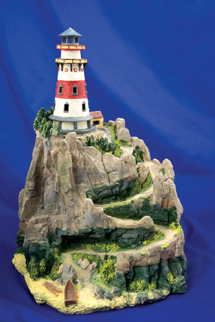A Tabletop Lighting System Sampler; We Work With The Lowel Ego, Interfit Pop-Up Light Tent, Sharpics D-Flector, Samigon Internet Photo Studio Pro, And Sunpak eBox
Selling collectibles, used cameras, confections, and a myriad of other items
online is an exploding phenomenon, but to sell effectively you have to show
the product off to advantage. Of course, tabletop photography extends beyond
the world of eBay. You may want to document small valuables for insurance purposes
or have loftier goals in the still life world. Any way you look at it, you need
a good tabletop setup to do the job right.
In the past, I've examined a few convenient tabletop systems, but I have
to admit that this group of products tops even those. We'll be looking
at the Lowel Ego, Interfit Pop-Up Light Tent, Sharpics D-Flector, Samigon Internet
Photo Studio Pro, and Sunpak eBox--each configured as an integrated tabletop
solution with two lights and a backdrop or backdrop support. All, except the
Sunpak unit, feature daylight-balanced spiral fluorescent bulbs, but whether
or not they are truly daylight-balanced we shall see. The Sunpak system makes
use of tungsten lights.
 |
|
|
|
 |
|
|
My Test Subjects
I selected two items that would be a challenge to photograph. On the one hand,
I wanted to show the products to advantage, but I also wanted the pictures to
be a true representation. What I didn't want was totally flat lighting,
which could also result in double shadows--something I took great pains
to avoid. The first object is a ceramic aquarium ornament that measures 12"
tall and 8" wide. This would test a system's ability to photograph
relatively large, opaque objects and to show off the ornament's sculpted
qualities.
 |
|
|
|
 |
|
|
The second item was a small glass fish (5" long x 4" high) that
was also a diorama of sorts. So it wasn't just a matter of highlighting
the transparent nature of the miniature, I also had to bring out the details
within, which also meant showing some of the figurine's flaws. If I were
photographing these items for a museum catalog or to document them, I would
likely take at least one picture that includes a ruler to show scale.
I spent several hours finessing each setup and trying to eliminate unnecessary
shadows and reflections, as the case may be. One problem with small sets is
that it is very difficult to keep glare off a seamless paper or shiny fabric
backdrop. Sometimes compromise was called for.
 |
|
|
|
 |
|
|
|
 |
|
|
|
 |
|
|
|
|
Tabletop Lighting Systems Tested
These systems do not throw enough light to overwhelm stray light that might
enter the picture, so I worked at night, with all other lights turned off. I
had two setups going concurrently, using both a breakfast nook and fabricated
table (long story, but it's an open file hanging system that I covered
over to form a working surface). Of course, lights were turned off on one setup
while I worked with the other. Once I finished working with each system, I focused
on doing something a bit more creative. The trick was in deciding which lighting
system would work best. I examined my options and made my choice.
- Log in or register to post comments

































